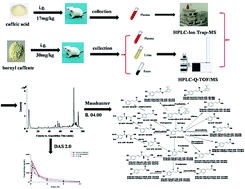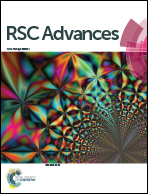Pharmacokinetic profile and metabolite identification of bornyl caffeate and caffeic acid in rats by high performance liquid chromatography coupled with mass spectrometry†
Abstract
Bornyl caffeate was initially discovered as a bioactive compound in medicinal plants. Despite the promising pharmacological activities including anti-tumor and antibacterial activities, the pharmacokinetics of the compound remain open. This work developed a high performance liquid chromatography-tandem mass spectrometric method for the determination of bornyl caffeate and caffeic acid (major metabolite and a main unit of bornyl caffeate) in vivo. Successful application of the method included identification of its metabolites and investigation on the drug pharmacokinetics. A total of 30 compounds were identified as the metabolites of bornyl caffeate in rats. We attributed these metabolites to phase I metabolic routes of reduction, oxidation, hydrolysis and phase II metabolic reactions of glucuronidation, sulfation, O-methylation and glycine. Glucuronidation, sulfation, O-methylation and reduction were the main metabolic pathways of bornyl caffeate. The method presented a linear range of 1–4000 ng mL−1. The pharmacokinetic profile of bornyl caffeate was found to be a three compartment open model, while caffeic acid fitted to a two compartment open model when it was administered alone or served as the main metabolite of bornyl caffeate. The time to peak concentration (Tmax) and the maximum plasma concentration (Cmax) of bornyl caffeate were 0.53 h and 409.33 ng mL−1. Compared with original caffeic acid, the compound displayed an increased half-life of elimination (T1/2β), area under the concentration time curve from 0 to t (AUC0–t) and area under the concentration time curve from 0 to ∞ (AUC0–∞), a decreased half-life of absorption (T1/2α) and an identical Cmax. Taking together, we concluded that bornyl caffeate is able to rapidly initiate therapeutic effect and last for a relatively long time in rats; metabolic pathways of O-methylation and reduction is key to interpret the mechanism and toxicity of bornyl caffeate.



 Please wait while we load your content...
Please wait while we load your content...